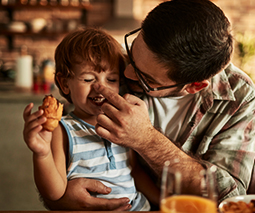Grandma’s car-seat warning after child is gravely injured in accident

A US grandmother has issued a sobering reminder about just how important it is to keep children rear-facing in their car seats.
Catastrophic injuries
Four-year-old Aniyah Bender’s spine was so badly injured when the car she was in crashed that a team of 30 doctors was on standby to treat her when she arrived in the emergency department.
“Surgeons reconnected her [severed] spine, and put pins in to hold it,” NBC News reports. “They’re also monitoring her spinal fluid, which may be leaking, and causing slight paralysis.”
“Aniyah was a little over 2 years old when the accident happened,” her grandmother Tanya Bender explained to website Her View From Home.
“She was waiting happily for her mom to pick her up for the day. We put the car seat in the car, forward-facing and strapped her in. They left the house and about 5 miles down the road, got in a car accident that resulted in the car hitting a brick pillar. The car flipped upside down.”
Please don’t forward-face small children
Benjamin Hoffman, a professor of pediatrics at Oregon Health & Science University School of Medicine told Forbes children have weak, fragile necks and big heads. This can make crashes catastrophic if they are strapped into forward-facing seats.
“Facing forward, the head and neck are thrown forward violently in a crash, and the same forces that can lead to whiplash in an adult can actually cause the spine of a young child to separate and injure the spinal cord.”
“If the child is rear-facing, all of the force is spread over the entire back of the child, allowing it to be absorbed by the seat, and cradling the head and neck to prevent injuries to that most vulnerable part of our body,” Professor Hoffman says.
Miracle survival
Tanya says doctors told her it’s rare for anyone to survive the injuries that Aniyah sustained, and that her movement will be severely limited because her spine was broken.
She wants to save other families the heartbreak they’ve endured.
“Parents need to keep their kiddos rear-facing as long as possible,” Tanya urges, saying the regret and guilt she suffers is “tremendous”.
“I think of it each day. I have horrible regret for not listening to others who told me to rear face longer. They only left the house for 5 minutes before I got the bone chilling call from her father who was face timing with her while the accident occurred.”
Of course, this is just a terrible accident and Tanya could not have known what lay ahead as she strapped her granddaughter into her seat. The family were complying with the law and had the correct kind of car seat – it’s just that they hadn’t adopted the extended rear-facing position that we now know is safest for small children.

Mixed messages
The laws vary in states across the US, and this Nanna is making it her mission to help parents understand the importance of rear-facing seats, via an awareness page on Facebook. It’s crazy that the law has not universally caught up with what’s safest for kids, because it means children like Aniyah are being hurt – or worse.
In Australia, the government-backed website childcarseats.com.au tells us that the law around kids and car seats is as follows:
- Children up to the age of six months must be secured in an approved rearward facing restraint.
- Children aged from six months old but under four years old must be secured in either a rear or forward-facing approved child restraint with an inbuilt harness.
The website says they are “a consortium of government agencies and motorist organisations who share a common interest in improving safety for children travelling in vehicles”. They officially advise parents to move your child to forward-facing only:
- When your baby is aged between 6 or 12 months (depending on the type of rearward facing child car seat you use) and is able to hold their head up; OR
- If your child car seat has shoulder marks printed or sewn on the cover, move your baby to a forward-facing car seat when his/her shoulders have passed the upper marks.
Slow down the switch
That said, sometimes we need to educate ourselves about safety issues, and this is one of those times. Slowing this switch from rear-facing to forward-facing is vital. While parents might be keen to see those little faces looking back at them in the rear-view mirror, there are so many life-saving and injury preventing reasons to delay this move.
Aniyah’s terrible experience shows us that rear-facing is best and research supports this, with experts advising kids remain rear-facing until they are at least two years old for optimal safety.
“If I had just taken the time to really listen to the people telling me to rear-face,” Tanya says, “I could have saved her from all of this.”









